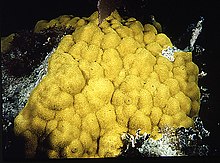Porites astreoides
| Porites astreoides | |
|---|---|
 |
|
| Scientific classification | |
| Kingdom: | Animalia |
| Phylum: | Cnidaria |
| Class: | Anthozoa |
| Subclass: | Hexacorallia |
| Order: | Scleractinia |
| Family: | Poritidae |
| Genus: | Porites |
| Species: | P. astreoides |
| Binomial name | |
|
Porites astreoides Lamarck, 1816 |
|
Porites astreoides is a colonial species of stony coral in the family Poritidae. Its common name is the mustard hill coral or the yellow porites. It is a common species growing in shallow water on reefs in the western Atlantic and Caribbean Sea.
When it grows in fast-flowing, shallow water, Porites astreoides is encrusting but in calmer water at medium depths it is a massive coral with a smooth, mounded, semi-spherical form and can grow to 60 centimetres (24 in) in diameter. At greater depths it is usually plate-like and in caves and under overhangs the plates are angled to receive the maximum amount of light. It is the only species within the genus Porites not to have a finger-like form. The corallites are small and tightly-packed and give the coral a porous appearance. The polyps each have six tentacles and are generally retracted during the day. This coral is yellow, yellowish-green, pale grey or pale brown, a colour given to it by the dinoflagellate zooxanthellae, microscopic algae that live symbiotically within the coral's tissue.
Porites astreoides is found in the tropical west Atlantic Ocean and the Caribbean Sea. Its range includes Florida, the banks off the Texas coast, the Bahamas and Bermuda. It is a common species on all parts of the reef and in lagoons. It usually grows in water less than 15 metres (49 ft) deep but may occasionally be found at depths of up to 50 metres (160 ft). It is sometimes free-living, growing on loose bits of coral, pebbles or mollusc shells. Large domed colonies sometimes appear to be separated into several lobes. This happens when part of the coral has died, and the living tissue in between the dead patches continues to develop, giving a clumped effect.
The polyps of Porites astreoides feed mostly at night, extending their tentacles to catch zooplankton and bacteria. The coral also obtains an important part of its nutritional needs as a result of the photosynthesis performed by the zooxanthellae in sunlight.
...
Wikipedia
